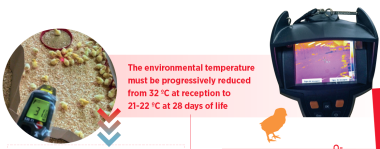
Hatchery
Key points during the rearing phase of broiler breeder pullets
To read more content about 2019
Hatchery
To read more content about 2019
Content available at:
Español (Spanish)
When we talk about the rearing phase of broiler breeder pullets, we look for help in broiler chickens’ starter manuals. The environmental conditions are essential, but the feeding management will be better if we think they are broiler breeder pullets and not chickens.
For the pullets’ management in this phase, our objective is not to obtain an excess on early bodyweight with voracious animals and great ease to gain weight because of its improved feed conversion ratio. Even an excessive yield would transform into a greater breast development. Therefore, the objective is to have uniform pullets without exceeding the recommended bodyweights. This allows weekly feed increments that supply the nutritional needs in each stage of the rearing without causing excessive weight gains.
Temperature control
Once the pullets arrive at the farm, the unloading process must be done quickly to avoid that trucks stay outdoors because it will cause loss of temperature and stress in the pullets.

The temperature must guarantee that pullets can sustain their body temperature since, during the first 5 days old, they pass to be poikilotherms animals to homeotherms.

To get optimum temperatures, it is necessary to pre-heat the house between 21 to 48 hours before pullets arrive. However, it depends on the season of the year
Ventilation
The ventilation must be turned off before the pullets’ placement to avoid unnecessary heat loss. Sometimes, it is preferable to pre-heat the house without litter extended on the floor. Once the floor reaches 28 degrees Celsius, the litter can be extended most uniformly.

The pullets from grandparent flocks with less than 30 weeks of age have 1 or 2 fewer temperature degrees during the first 7 days of age than those from older flocks under the same environmental conditions. At placement, these small pullets can require temperatures of